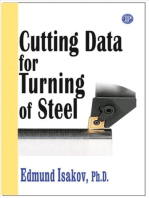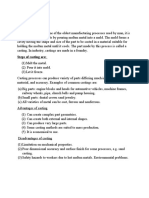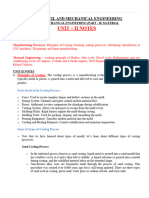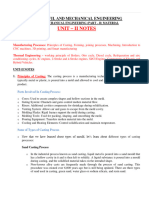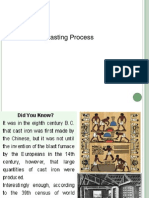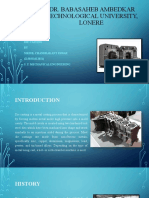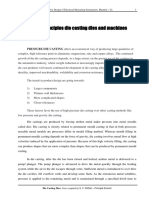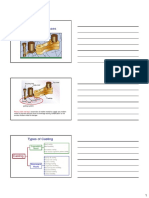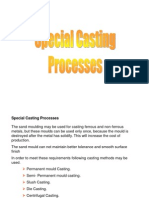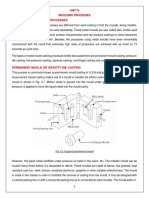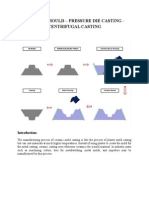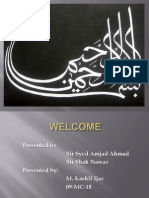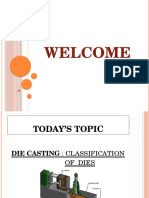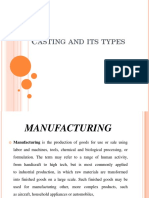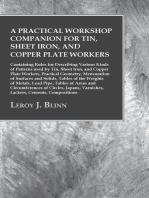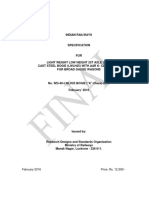Professional Documents
Culture Documents
Equipment Design and Drawing: Project Report
Equipment Design and Drawing: Project Report
Uploaded by
surajagtap010 ratings0% found this document useful (0 votes)
61 views40 pagesThis document provides information on various metal casting processes including die casting, centrifugal casting, and sand casting. It discusses the key steps in each process, their advantages and disadvantages, and common applications. Die casting is characterized by forcing molten metal into a mold cavity under high pressure and can produce large quantities of parts quickly. Centrifugal casting is used to cast thin-walled cylinders and involves pouring molten metal into a rotating mold. Sand casting uses sand as the mold material and is commonly used for ferrous and non-ferrous metals.
Original Description:
casing
Original Title
Casting
Copyright
© © All Rights Reserved
Available Formats
PDF, TXT or read online from Scribd
Share this document
Did you find this document useful?
Is this content inappropriate?
Report this DocumentThis document provides information on various metal casting processes including die casting, centrifugal casting, and sand casting. It discusses the key steps in each process, their advantages and disadvantages, and common applications. Die casting is characterized by forcing molten metal into a mold cavity under high pressure and can produce large quantities of parts quickly. Centrifugal casting is used to cast thin-walled cylinders and involves pouring molten metal into a rotating mold. Sand casting uses sand as the mold material and is commonly used for ferrous and non-ferrous metals.
Copyright:
© All Rights Reserved
Available Formats
Download as PDF, TXT or read online from Scribd
Download as pdf or txt
0 ratings0% found this document useful (0 votes)
61 views40 pagesEquipment Design and Drawing: Project Report
Equipment Design and Drawing: Project Report
Uploaded by
surajagtap01This document provides information on various metal casting processes including die casting, centrifugal casting, and sand casting. It discusses the key steps in each process, their advantages and disadvantages, and common applications. Die casting is characterized by forcing molten metal into a mold cavity under high pressure and can produce large quantities of parts quickly. Centrifugal casting is used to cast thin-walled cylinders and involves pouring molten metal into a rotating mold. Sand casting uses sand as the mold material and is commonly used for ferrous and non-ferrous metals.
Copyright:
© All Rights Reserved
Available Formats
Download as PDF, TXT or read online from Scribd
Download as pdf or txt
You are on page 1of 40
Project Report
EQUIPMENT DESIGN AND
DRAWING
1
QUESTION 1
Hot, cold die casting, centrifugal casting process, sand
casting. Its use for process equipments. Advantages and
disadvantages.
2
CASTING
Casting is a manufacturing process by which a liquid
material is usually poured into a mold, which contains a
hollow cavity of the desired shape, and then allowed to
solidify.
The solidified part is also known as a casting, which is ejected
or broken out of the mold to complete the process.
3
TYPES OF CASTING METHODS
The different types of methods used for casting are:
1) Die Casting
a) Hot Die Casting
b) Cold Die Casting
2) Centrifugal Casting
3) Sand Casting
4
DIE CASTING
5
DIE CASTING
Die casting is a metal casting process that is characterized by
forcing molten metal under high pressure into a mould
cavity.
The advantage to the die casting process is the ability to make
large quantities of well defined components quickly and
cheaply that will require few secondary operations to obtain
a finished part.
6
DIE CASTING
The two types of die casting process that we are going to see
are:
1) Hot die casting
2) Cold die casting
7
COLD DIE CASTING
8
COLD DIE CASTING
During the cold-chamber die casting process, the molten charge
(more material than is required to fill the casting) is ladled from
the crucible into a shot sleeve, where a hydraulically
operated plunger pushes the metal into the die.
The extra material is used to force additional metal into the die
cavity to supplement the shrinkage that takes place during
solidification.
Injection pressures over 10,000 psi or 70,000 kPa can be obtained
from this type of machine.
9
10
Operating Sequence of the Cold-Chamber
Die Casting Process
11
1. The die is closed and the molten metal is ladled into the cold-chamber
shot sleeve
12
2. The plunger pushes the molten metal into the die cavity where it is
held under pressure until solidification.
13
3. The die opens and the plunger advances, to ensure that the casting
remains in the ejector die. Cores, if any, retract.
14
4. Ejector pins push the casting out of the ejector die and the plunger
returns to its original position
15
ADVANTAGES
The big advantage of cold chamber die castings is that the
procedure can make denser metal castings.
Denser metal is produced due to the higher pressure used
during the injection process.
Low maintenance cost.
Through cold chamber castings, producers can
manufacture more parts with lower overhead costs. This
drives down the market prices.
16
DISADVANTAGES
Cold chamber processing has slower production cycles.
The molten metal in the cold chamber can cool down even
before injection.
The molten metal in the cold chamber is more exposed to
oxidation and other contaminants especially if the
production floor does not have strict quality control.
17
APPLICATIONS
Since the liquid metal is brought in from an outside source
and is not always in contact with the machine apparatus it can
be used for the casting of higher melting point metals.
Consequently, higher melting point alloys of aluminium,
brass, copper, and aluminium-zinc are often metal cast
in manufacturing industry using cold chamber die casting.
18
HOT DIE CASTING
19
HOT DIE CASTING
In this process, the injector is submerged in the molten metal
(Hot chamber).
The apparatus consists of a shot cylinder connected to
plunger rod, which provides power for the injection of the
molten metal into the die.
The plunger is in contact with the molten metal.
20
HOT DIE CASTING
21
HOT DIE CASTING
At the start of a casting cycle the plunger is at the top of the
hot chamber. Intake ports allow this chamber to fill with
liquid metal.
22
1 2
3
4
23
APPLICATIONS
The hot chamber process is used for metals of low melting
point and high fluidity such as tin, zinc, and lead that tend
not to alloy easily with steel at their melt temperatures.
24
ADVANTAGES
Good surface finish
Very economical process at high volume production
Fine Grain structure and good mechanical properties are
achieved.
Small size parts may be produced
25
DISADVANTAGES
Not applicable for high melting point metals and alloys (e.g.:
steel)
Large parts can not be cast.
High die cost
Some gases maybe entrapped in form of porosity.
26
CENTRIFUGAL CASTING
27
CENTRIFUGAL CASTING
Centrifugal casting or rotocasting is a casting technique
that is typically used to cast thin-walled cylinders
Centrifugal casting was the invention of Alfred Krupp, who
used it to manufacture cast steel tyres for railway wheels in
1852.
Materials that can be casted using centrifugal casting
are iron, steel, stainless steel, glass, and alloys
of aluminium, copper and nickel.
28
PROCESS
1) Mold preparation - The walls of a cylindrical mold are first coated with a
refractory ceramic coating and the mold is rotated about its axis at high speeds
(300-3000 RPM), typically around 1000 RPM.
2) Pouring - Molten metal is poured directly into the rotating mold. The
centrifugal force drives the material towards the mold walls as the mold fills.
3) Cooling - With all of the molten metal in the mold, the mold remains spinning
as the metal cools. Cooling begins quickly at the mold walls and proceeds
inwards.
4) Casting removal - After the casting has cooled and solidified, the rotation is
stopped and the casting can be removed.
5) Finishing - While the centrifugal force drives the dense metal to the mold
walls, any less dense impurities or bubbles flow to the inner surface of the
casting. As a result, secondary processes such as machining, grinding, or sand-
blasting, are required to clean and smooth the inner diameter of the part.
29
30
ADVANTAGES
Good mechanical properties
Good surface finish and accuracy
Low equipment cost
Low labour cost
Little scrap generated
Can form very large parts
31
DISADVANTAGES
Only cylindrical shapes can be produced with this process.
Secondary machining is often required for inner diameter
Long lead time possible
32
APPLICATIONS
Shock Absorber Cylinders, Stabilizers, and Dumper
Cylinders for off-road heavy-duty mining trucks
Shear and Crusher Cylinders for demolition or recycling
applications
Riser Tensioner Cylinders for offshore oil platforms
Building Stabilizer Cylinders for earthquake protection.
33
SAND CASTING
34
SAND CASTING
Also known as sand molded casting
Characterized by using sand as the mold material.
Over 70% of all metal castings are produced via a sand
casting process
Materials used to make patterns: Wood, plastics,
aluminum, fiberglass, cast iron
35
BASIC PROCESS
1. Place a pattern in sand to create a mold.
2. Incorporate the pattern and sand in a gating system.
3. Remove the pattern.
4. Fill the mold cavity with molten metal.
5. Allow the metal to cool.
6. Break away the sand mold and remove the casting.
36
FORMATION PROCESS
SAND CAST FORMATION:
1. Metal springs called densiments are placed into the mold-provide uniform
solidification of the metal throughout the mold.
2. Nails are inserted into thin parts- reinforcement
3. alcoholic liquid is sprayed over the cope and heated with flames- harden and to
dry the surface.
METAL CASTING :
1. Metal box is made of two halves called mould which is separated by a
parting line- the removal of the part.
2. The upper part of the mold is called the cope and the lower part called the
drag.
3. Cope and drag are united and metal is poured into it through a canal called
sprue
4. At the bottom of the sprue there is a gap called well for the collection of
the unwanted sand, which comes with the flowing metal.
37
SUPPLEMENTARY PROCESS
Chill:
A casting may show micro porosity due to solidification.
Eliminated with directional solidification by
1. Incorporating a metal chill into the mold
2. Tapering the thinnest section of the runner
Electric-Arc Furnaces:
Steel melted in the electric arc process is melted and the molten metal is
filed into mould basin.
A powder is added to the mold's surface to prevent metal's rapid cooling
during pouring and prevent the oxidation of the molten metal and is
removed using vibrating platform.
Excess parts are cut either by oxygen if the casting is of steel (hard), or
by hammering if the casting is of cast iron (brittle).
38
ADVANTAGES
1) Complex pad geometries, including Goth external arid
internal shapes.
2) Performed on any metal that can be heated to the liquid
state.
3) Highly suited for mass production.
4) Easiest and quickest way (technique) from drawing (design)
to the production.
5) Used in specialized factories called foundries
39
DISADVANTAGES
1) Limitation on mechanical properties
2) Porosity (empty spaces within the metal - reduces the
strength of metal)
3) Poor dimensional accuracy and surface finish
4) Safety hazards to humans and environmental problems
5) Removal of pattern of the thin and small parts is very
difficult
40
You might also like
- Pressure Die CastingDocument62 pagesPressure Die CastingChetan Nehete100% (2)
- Creating A EngobeDocument105 pagesCreating A Engobeduyen nguyen chi luongNo ratings yet
- Die CastingDocument6 pagesDie Castingkutik3bugerNo ratings yet
- Astm 608 PDFDocument6 pagesAstm 608 PDFIslam FawzyNo ratings yet
- Casting Process: Steps of Casting AreDocument10 pagesCasting Process: Steps of Casting AreReham Emad Ezzat MohamedNo ratings yet
- BCMEDocument35 pagesBCMErupanandaNo ratings yet
- BCM 2Document34 pagesBCM 2rupanandaNo ratings yet
- Manufacturing Processes Manufacturing Processes ME ME - 222 222Document66 pagesManufacturing Processes Manufacturing Processes ME ME - 222 222shahnawaz875No ratings yet
- PNC3 - Casting IIDocument4 pagesPNC3 - Casting IIAlpNo ratings yet
- Pressure Die CastingDocument62 pagesPressure Die CastingARUNSFRH83% (6)
- CH 7-Methods of CastingDocument44 pagesCH 7-Methods of CastingGosaye DesalegnNo ratings yet
- CastingDocument8 pagesCastingTody IsfitazliNo ratings yet
- Chapter 3 - METAL WORK, CASTING PROCESS AND HEAT TREATMENT ON STEELDocument21 pagesChapter 3 - METAL WORK, CASTING PROCESS AND HEAT TREATMENT ON STEELتاج نيسهاNo ratings yet
- Metal CastingDocument40 pagesMetal CastingFahmi Sanji AlexanderNo ratings yet
- DM-1 CO-1 Special Castings MaterialDocument9 pagesDM-1 CO-1 Special Castings MaterialSree vishnu Sai chandan guntupalliNo ratings yet
- 1.6.1 Die Casting (Pressure Die Casting) : Module-I of Manufacturing Science-IDocument8 pages1.6.1 Die Casting (Pressure Die Casting) : Module-I of Manufacturing Science-IChinmay Das100% (2)
- Dr. Babasaheb Ambedkar Technological University, LonereDocument36 pagesDr. Babasaheb Ambedkar Technological University, LonereNikhil PawarNo ratings yet
- Die Casting - 1Document103 pagesDie Casting - 1Ritu MaityNo ratings yet
- Permanent Mold Casting Processes: Usually Made From Metal Gas Pressure or A Vacuum UsedDocument57 pagesPermanent Mold Casting Processes: Usually Made From Metal Gas Pressure or A Vacuum UsedJacob KussiaNo ratings yet
- Project ReportDocument31 pagesProject ReportManik ChauhanNo ratings yet
- Casting ProcessesDocument20 pagesCasting ProcessesVv4HNo ratings yet
- Die Casting: Mechanical Manufacturing - IIDocument39 pagesDie Casting: Mechanical Manufacturing - IIAdnan Javed100% (1)
- Special Casting ProcessesDocument31 pagesSpecial Casting Processesdarshan_rudraNo ratings yet
- 04 CastingDocument26 pages04 CastingSports GloballyNo ratings yet
- Metal Mould-Casting Processes: Unit Iv Moulding ProcessesDocument26 pagesMetal Mould-Casting Processes: Unit Iv Moulding ProcessesMr. T. Anjaneyulu Mr. T. AnjaneyuluNo ratings yet
- Sess 9 (Ceramic Mould - Pressure Die Casting - Centrifugal Casting)Document7 pagesSess 9 (Ceramic Mould - Pressure Die Casting - Centrifugal Casting)Prakash RagupathyNo ratings yet
- Lec 5Document39 pagesLec 5Omar AssalNo ratings yet
- Week 2 Advanced Workshop PracticeDocument28 pagesWeek 2 Advanced Workshop PracticeBasit AliNo ratings yet
- ميحرلا نمحرلا الله مسب Manufacturing Processes 0703314: Solidification and Casting ProcessesDocument45 pagesميحرلا نمحرلا الله مسب Manufacturing Processes 0703314: Solidification and Casting ProcessesAbdullahNo ratings yet
- Unit - 1 Metal Casting Processes-NVRDocument287 pagesUnit - 1 Metal Casting Processes-NVRPrashon GNo ratings yet
- Long AnswerDocument3 pagesLong AnswerVarinder MouryaNo ratings yet
- Mechanical Castings Ppt-2Document49 pagesMechanical Castings Ppt-2PubgArena 01No ratings yet
- Special CastingDocument46 pagesSpecial CastingJith Viswa100% (1)
- Mce329 - Sand CastingDocument42 pagesMce329 - Sand CastingIndian MHNo ratings yet
- Assignment: Submitted To: Miss Sobia Anwar Submitted By: Uzair Khan (2018-CH-01)Document12 pagesAssignment: Submitted To: Miss Sobia Anwar Submitted By: Uzair Khan (2018-CH-01)Uzair KhanNo ratings yet
- ME6352 Manufacturing Technolgy: Unit I Casting 8Document54 pagesME6352 Manufacturing Technolgy: Unit I Casting 8Aravind PhoenixNo ratings yet
- 1st Class 13.01.2020Document18 pages1st Class 13.01.2020EDISON OCHIENGNo ratings yet
- Die CastingDocument29 pagesDie CastingUmair MirzaNo ratings yet
- 15ae307j - Aees - Unit 3Document41 pages15ae307j - Aees - Unit 3Aahana KhannaNo ratings yet
- Unit-3 - Special Moulding Processes PART-2Document25 pagesUnit-3 - Special Moulding Processes PART-2mahammad kamaluddeenNo ratings yet
- Topic 4 - Metal CastingDocument31 pagesTopic 4 - Metal CastingKelvin KVNo ratings yet
- 2nd Class Notes 17.01Document48 pages2nd Class Notes 17.01EDISON OCHIENGNo ratings yet
- Types of CastingDocument14 pagesTypes of CastingRamoji Aditya Chary100% (2)
- Ae15301 AMMTDocument98 pagesAe15301 AMMTDurai Raj KumarNo ratings yet
- Casting 1Document26 pagesCasting 1Lal KishanNo ratings yet
- Fundamentals of CastingDocument18 pagesFundamentals of CastingmutuajayNo ratings yet
- SCP (Solid Casting Processes)Document12 pagesSCP (Solid Casting Processes)jesssepinkman03No ratings yet
- Lecture 2 - Manufacturing Processes - Fundamentals of Metal Casting and Casting Design - DR Bilal AhmadDocument99 pagesLecture 2 - Manufacturing Processes - Fundamentals of Metal Casting and Casting Design - DR Bilal Ahmadjawad khalidNo ratings yet
- Production TechnologyDocument60 pagesProduction Technology2mohan7100% (2)
- Casting Its TypesDocument84 pagesCasting Its Typesanmanjunath086No ratings yet
- Die Casting ProcessDocument23 pagesDie Casting ProcessshayarigurunitinNo ratings yet
- N CGLDocument70 pagesN CGLjoshibecNo ratings yet
- 2.14. Multiple-Use-Mould Casting ProcessesDocument3 pages2.14. Multiple-Use-Mould Casting Processesaman chaudharyNo ratings yet
- MOdule II 2 PageDocument2 pagesMOdule II 2 PageVyshakh SunilNo ratings yet
- Sheet Metalwork on the Farm - Containing Information on Materials, Soldering, Tools and Methods of Sheet MetalworkFrom EverandSheet Metalwork on the Farm - Containing Information on Materials, Soldering, Tools and Methods of Sheet MetalworkNo ratings yet
- Oxy-Acetylene Welding and Cutting: Electric, Forge and Thermit Welding together with related methods and materials used in metal working and the oxygen process for removal of carbonFrom EverandOxy-Acetylene Welding and Cutting: Electric, Forge and Thermit Welding together with related methods and materials used in metal working and the oxygen process for removal of carbonNo ratings yet
- Oxy-Acetylene Welding and Cutting Electric, Forge and Thermit Welding together with related methods and materials used in metal working and the oxygen process for removal of carbonFrom EverandOxy-Acetylene Welding and Cutting Electric, Forge and Thermit Welding together with related methods and materials used in metal working and the oxygen process for removal of carbonNo ratings yet
- A Practical Workshop Companion for Tin, Sheet Iron, and Copper Plate Workers: Containing Rules for Describing Various Kinds of Patterns used by Tin, Sheet Iron, and Copper Plate Workers, Practical Geometry, Mensuration of Surfaces and Solids, Tables of the Weights of Metals, Lead Pipe, Tables of Areas and CircumferencesFrom EverandA Practical Workshop Companion for Tin, Sheet Iron, and Copper Plate Workers: Containing Rules for Describing Various Kinds of Patterns used by Tin, Sheet Iron, and Copper Plate Workers, Practical Geometry, Mensuration of Surfaces and Solids, Tables of the Weights of Metals, Lead Pipe, Tables of Areas and CircumferencesNo ratings yet
- Triangulation - Applied to Sheet Metal Pattern Cutting - A Comprehensive Treatise for Cutters, Draftsmen, Foremen and Students: Progressing from the Simplest Phases of the Subject to the Most Complex Problems Employed in the Development of Sheet Metal Patterns with Practical Solutions of Numerous Problems of Frequent Occurrence in Sheet Metal ShopsFrom EverandTriangulation - Applied to Sheet Metal Pattern Cutting - A Comprehensive Treatise for Cutters, Draftsmen, Foremen and Students: Progressing from the Simplest Phases of the Subject to the Most Complex Problems Employed in the Development of Sheet Metal Patterns with Practical Solutions of Numerous Problems of Frequent Occurrence in Sheet Metal ShopsRating: 5 out of 5 stars5/5 (1)
- Welding Terminology: A Guide to MIG, TIG, Stick, Gas, and Spot Welding TermsFrom EverandWelding Terminology: A Guide to MIG, TIG, Stick, Gas, and Spot Welding TermsNo ratings yet
- Gives Concentraion of Vesicles Produced: Input InputDocument1 pageGives Concentraion of Vesicles Produced: Input Inputsurajagtap01No ratings yet
- MSDS TemplateDocument3 pagesMSDS Templatesurajagtap01No ratings yet
- Generally Cascade Controller Is Used To Control Temperature of Exothermic Reaction With Cooling Water. 2 Components: 1. Master Loop 2. Slave LoopDocument1 pageGenerally Cascade Controller Is Used To Control Temperature of Exothermic Reaction With Cooling Water. 2 Components: 1. Master Loop 2. Slave Loopsurajagtap01No ratings yet
- Indsutrial Management BooksDocument1 pageIndsutrial Management Bookssurajagtap01No ratings yet
- Nam e of Company: Reliance Industries LimitedDocument1 pageNam e of Company: Reliance Industries Limitedsurajagtap01No ratings yet
- Radiographic TestingDocument35 pagesRadiographic Testingsurajagtap01No ratings yet
- LipidsDocument86 pagesLipidssurajagtap01No ratings yet
- Eddy Current TestingDocument43 pagesEddy Current Testingsurajagtap01100% (2)
- Biochemical EngineeringDocument28 pagesBiochemical Engineeringsurajagtap010% (1)
- Casting and Welding 2 Mark QuestionsDocument8 pagesCasting and Welding 2 Mark Questionsvmgobinath0% (1)
- A Comprehensive Review On Aluminium Syntactic Foams Obtained by Dispersion Fabrication MethodsDocument6 pagesA Comprehensive Review On Aluminium Syntactic Foams Obtained by Dispersion Fabrication MethodsRoland EndrészNo ratings yet
- ProjectDocument34 pagesProjectSTAR PRINTINGNo ratings yet
- HMT Training Report PDFDocument40 pagesHMT Training Report PDFMohammedNo ratings yet
- Alloy WheelsDocument1 pageAlloy WheelsEnijad ArnautNo ratings yet
- Hot Tears in CastingDocument15 pagesHot Tears in CastingRafdi Abdul MajidNo ratings yet
- Prevention Pave CrackingDocument136 pagesPrevention Pave Crackingbloomdido100% (2)
- Investment CastingDocument20 pagesInvestment CastingLuís CamposNo ratings yet
- The Effect of Iron in Al-Si Casting Alloys: October 2004Document11 pagesThe Effect of Iron in Al-Si Casting Alloys: October 2004Jothi ManiNo ratings yet
- Final Specification - STR No. WD-40-LWLH25 Bogie-K-class Dated 26-02-16 PDFDocument61 pagesFinal Specification - STR No. WD-40-LWLH25 Bogie-K-class Dated 26-02-16 PDFAbhishek Tripathi100% (1)
- The Ice Cleat For The M1 Abrams Tank PDFDocument26 pagesThe Ice Cleat For The M1 Abrams Tank PDFLe VoyageurNo ratings yet
- 90 Years of Thermal Analysis As A Control Tool in The Melting of Cast IronDocument16 pages90 Years of Thermal Analysis As A Control Tool in The Melting of Cast IronDouglas RodriguesNo ratings yet
- Sae Technical Paper Series: Alan P. Druschitz, Thomas E. Prucha, Adam E. Kopper and Thomas A. ChadwickDocument9 pagesSae Technical Paper Series: Alan P. Druschitz, Thomas E. Prucha, Adam E. Kopper and Thomas A. ChadwickAliakbar SaifeeNo ratings yet
- DCM EnggDocument30 pagesDCM EnggManil KumarNo ratings yet
- M Tech - Manufacturing-Technology Course STR and SyllabusDocument23 pagesM Tech - Manufacturing-Technology Course STR and SyllabusarjunNo ratings yet
- 3D Printing Method of Fabrication For Metals, Ceramics, and Multi-Materials Using A Universal Self-Curable Technique For Robocasting PDFDocument8 pages3D Printing Method of Fabrication For Metals, Ceramics, and Multi-Materials Using A Universal Self-Curable Technique For Robocasting PDFoguNo ratings yet
- Foundry Notes by ShiftyDocument22 pagesFoundry Notes by ShiftyRaiyan Shifty100% (1)
- Continuous CastingDocument67 pagesContinuous CastingPatel Ki Bahu100% (1)
- Welding and Casting ProcessDocument84 pagesWelding and Casting ProcessSharif OsmanNo ratings yet
- Conbextra GP TDSDocument4 pagesConbextra GP TDSMoataz MedhatNo ratings yet
- High Integrity Aluminum (GENERAL)Document140 pagesHigh Integrity Aluminum (GENERAL)Kmilo Giraldo100% (3)
- Austempered Ductile Iron Castings: Standard Specification ForDocument8 pagesAustempered Ductile Iron Castings: Standard Specification ForJosé Ramón GutierrezNo ratings yet
- DFM Lab RepotDocument30 pagesDFM Lab Repotapi-286147226No ratings yet
- Tutorial QuestionsDocument7 pagesTutorial QuestionsSubash EsNo ratings yet
- Tratamientos ArticuloDocument9 pagesTratamientos ArticuloYersonAmayaNo ratings yet
- VizagSteel MgmtTRAINEEDocument28 pagesVizagSteel MgmtTRAINEERaghu88% (16)
- A 159 - 83 (2015)Document5 pagesA 159 - 83 (2015)phaindikaNo ratings yet



